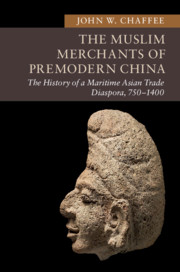30 results
Introduction
-
- Book:
- The Muslim Merchants of Premodern China
- Published online:
- 13 August 2018
- Print publication:
- 23 August 2018, pp 1-11
-
- Chapter
- Export citation
2 - The Reorientation of Trade
-
- Book:
- The Muslim Merchants of Premodern China
- Published online:
- 13 August 2018
- Print publication:
- 23 August 2018, pp 51-75
-
- Chapter
- Export citation
Contents
-
- Book:
- The Muslim Merchants of Premodern China
- Published online:
- 13 August 2018
- Print publication:
- 23 August 2018, pp v-v
-
- Chapter
- Export citation
Maps
-
- Book:
- The Muslim Merchants of Premodern China
- Published online:
- 13 August 2018
- Print publication:
- 23 August 2018, pp vii-vii
-
- Chapter
- Export citation
3 - The Maturation of Merchant Communities
-
- Book:
- The Muslim Merchants of Premodern China
- Published online:
- 13 August 2018
- Print publication:
- 23 August 2018, pp 76-123
-
- Chapter
- Export citation
4 - The Mongols and Merchant Power
-
- Book:
- The Muslim Merchants of Premodern China
- Published online:
- 13 August 2018
- Print publication:
- 23 August 2018, pp 124-161
-
- Chapter
- Export citation
Copyright page
-
- Book:
- The Muslim Merchants of Premodern China
- Published online:
- 13 August 2018
- Print publication:
- 23 August 2018, pp iv-iv
-
- Chapter
- Export citation
Figures
-
- Book:
- The Muslim Merchants of Premodern China
- Published online:
- 13 August 2018
- Print publication:
- 23 August 2018, pp vi-vi
-
- Chapter
- Export citation
Acknowledgments
-
- Book:
- The Muslim Merchants of Premodern China
- Published online:
- 13 August 2018
- Print publication:
- 23 August 2018, pp viii-xiv
-
- Chapter
- Export citation
5 - Endings and Continuities
-
- Book:
- The Muslim Merchants of Premodern China
- Published online:
- 13 August 2018
- Print publication:
- 23 August 2018, pp 162-180
-
- Chapter
- Export citation
1 - Merchants of an Imperial Trade
-
- Book:
- The Muslim Merchants of Premodern China
- Published online:
- 13 August 2018
- Print publication:
- 23 August 2018, pp 12-50
-
- Chapter
-
- You have access
- HTML
- Export citation
Index
-
- Book:
- The Muslim Merchants of Premodern China
- Published online:
- 13 August 2018
- Print publication:
- 23 August 2018, pp 197-210
-
- Chapter
- Export citation
Bibliography
-
- Book:
- The Muslim Merchants of Premodern China
- Published online:
- 13 August 2018
- Print publication:
- 23 August 2018, pp 181-196
-
- Chapter
- Export citation

The Muslim Merchants of Premodern China
- The History of a Maritime Asian Trade Diaspora, 750–1400
-
- Published online:
- 13 August 2018
- Print publication:
- 23 August 2018
Contents
-
- Book:
- The Cambridge History of China
- Published online:
- 05 March 2015
- Print publication:
- 05 March 2015, pp vii-x
-
- Chapter
- Export citation
Abbreviations
-
- Book:
- The Cambridge History of China
- Published online:
- 05 March 2015
- Print publication:
- 05 March 2015, pp xiii-xiv
-
- Chapter
- Export citation
Maps
-
- Book:
- The Cambridge History of China
- Published online:
- 05 March 2015
- Print publication:
- 05 March 2015, pp xii-xii
-
- Chapter
- Export citation
Frontispiece
-
- Book:
- The Cambridge History of China
- Published online:
- 05 March 2015
- Print publication:
- 05 March 2015, pp ii-iv
-
- Chapter
- Export citation
Chapter 5 - Sung education: Schools, academies, and examinations
-
-
- Book:
- The Cambridge History of China
- Published online:
- 05 March 2015
- Print publication:
- 05 March 2015, pp 286-320
-
- Chapter
- Export citation
Bibliography
-
- Book:
- The Cambridge History of China
- Published online:
- 05 March 2015
- Print publication:
- 05 March 2015, pp 791-884
-
- Chapter
- Export citation



